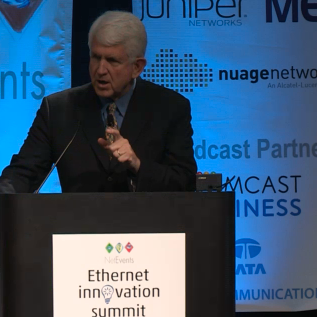On May 22, 1973, Xerox PARC researcher Bob Metcalfe drew a diagram that would change the world. That diagram detailed how an Ethernet network could work.
At the Ethernet Innovation Summit today, Metcalfe explained how Ethernet came to
Metcalfe said that the initial implementation of Ethernet was delivered via a thick coaxial cable because it could be tapped passively. Even in 1973, however, he anticipated that other media would be used in time.
“So we didn’t call it CoaxNet. We called it Ethernet because the Ether could be coax, twisted pair, radio, optical cables, powerline, or whatever you want,” Metcalfe said.
Although Ethernet was conceived in 1973, Metcalfe said that it wasn’t until the arrival of the IBM PC in August of 1981 that there was a personal computer worthy of Ethernet. The other big break for Ethernet didn’t happen until the late 1980s, with the switch from coax to twisted-pair cabling.
Token Ring
“We were fighting in the market with IBM’s Token Ring, which used twisted pair, and customers kind of liked that, so Ethernet became twisted pair too, and that sealed the doom of Token Ring,” Metcalfe said.
Metcalfe was terrified of Token Ring for a long time, because of the power of IBM. He said that people had been telling him every day for 10 years that Token Ring would kill Ethernet and that Ethernet had no future.
“What IBM underestimated in their dominance was the power of an open standard,” Metcalfe said. “In that old IBM, in its dark little heart, it was not committed to open standards, and its products were not interoperable.”
In contrast, Ethernet from its inception was conceived and deployed as an open standard.
Metcalfe’s Law
Metcalfe’s Law states that the value of a network goes up as a function of the square of the number of participants.
It’s that law that has now made Ethernet incredibly valuable 40 years after Metcalfe first helped to conceive it. One of the things that Ethernet now enables is a new era of Massively Open Online Courses (MOOCs), which are changing the educational paradigm.
“Like we solved bandwidth with the Internet, we’re now going to solve ignorance with the Internet,” Metcalfe said.
Sean Michael Kerner is a senior editor at Enterprise Networking Planet and InternetNews.com. Follow him on Twitter @TechJournalist.


